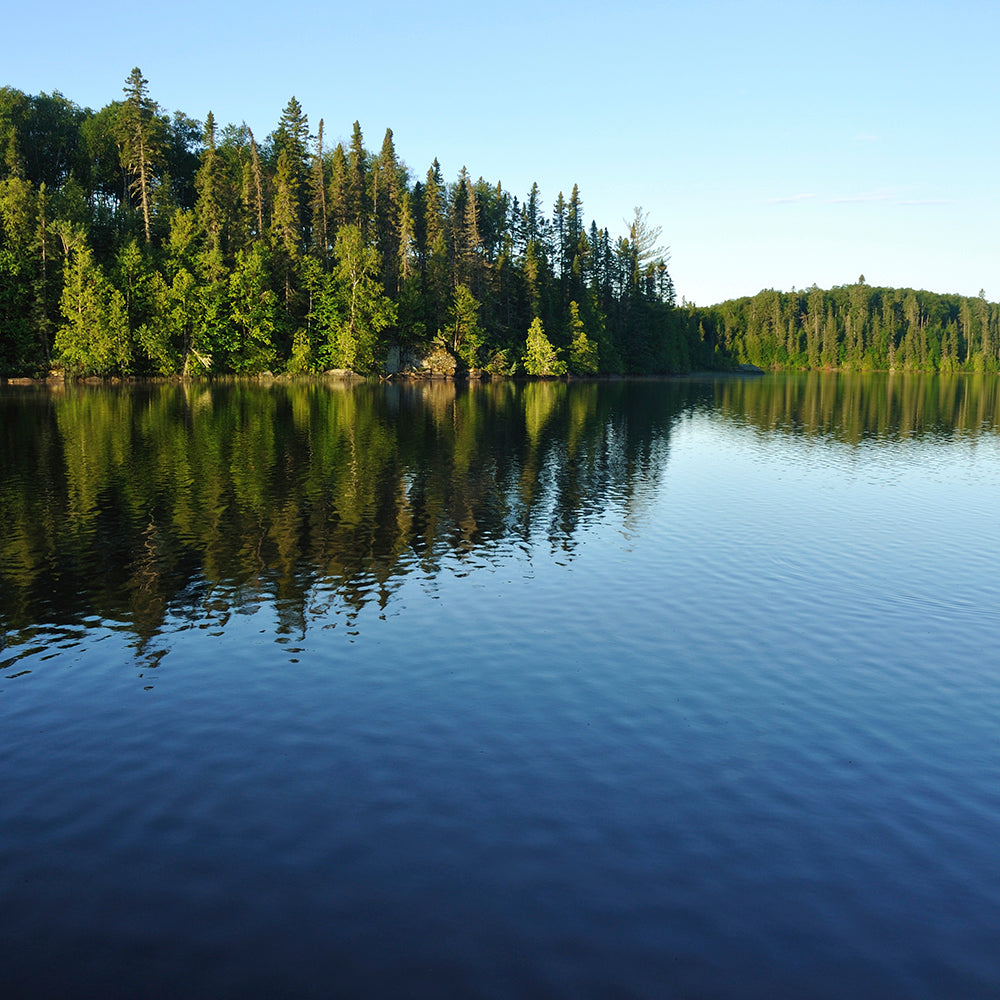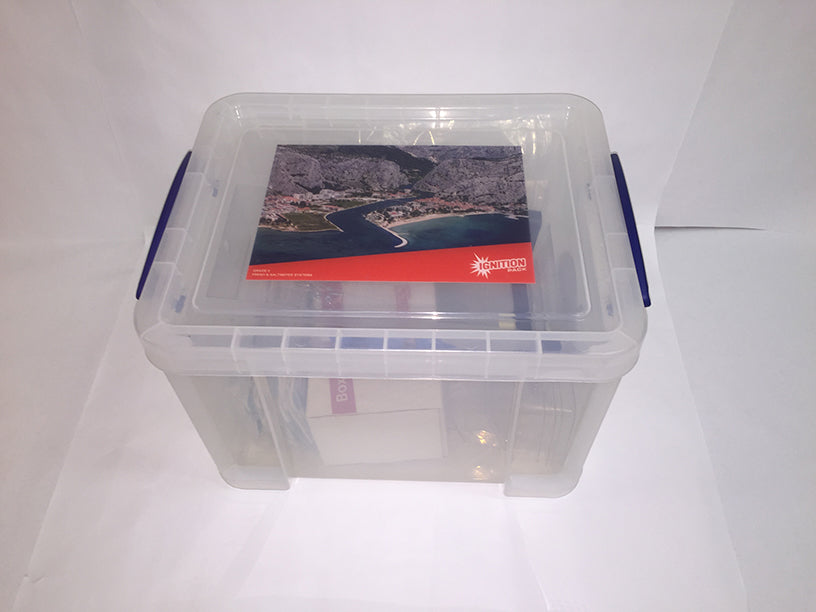MindFuel
Ignition Pack - Fresh & Saltwater Systems Unit
Ignition Pack - Fresh & Saltwater Systems Unit
Couldn't load pickup availability
Physical Kit and Online Access
Providing 20 instructional hours, each of the five unit sections, ideal for grade 8, has a suite of resources with common elements:
- Lessons: These comprehensive PowerPoint presentations use illustrations and examples to provide opportunities for classroom discussion and exploration of key concepts.
- Real World Videos: These videos feature scientists, educators and artists who demonstrate real-world applications of the science presented in each topic and make meaningful career connections for students.
- Activities: Hands-on activities and experiments give students the chance to explore the science concepts of each topic through active investigation. They are accessible on the Ignition Pack website and in the Activity Book.
- Cards: The Word Cards and Definition Cards support students with learning and reviewing new science vocabulary.
- Teacher's Handbook: This handbook explains how to use all of the Ignition Pack resources. There is also a separate Activity Book that outlines all the lessons and activities.
- Physical Kit: This kit contains many of the specialized items needed for a variety of the activities, including materials to build a stream.
- Panoramas: The panoramas, which are directly connected to the activities, help students to explore freshwater and saltwater habitats. For example, with the Glaciers and Mountains Panorama students study a mountain panorama that challenges them to explain what they see. With the Ocean Habitats Panorama, they learn about how some animals have adapted to live in the Nile River.
The Fresh and Saltwater Systems unit is broken into five sections:
- Section 1
- Section 2
- Section 3
- Section 4
- Section 5
Section 1: "Why and Where Do We Search for Water?" is approximately 180 minutes long and includes:
- Interactive Lesson: In this set of lessons students consider: Where can water be found on Earth? What forms does water take around the globe? How does water support life? How do humans affect aquatic environments?
- Water Use Challenge Activity: In this activity, students will discover how much water they use in a day. They’ll also learn about the effects of their water use on water quality and quantity.
- What Do Indicator Species Indicate Activity: Students have already learned a little about water quality and what affects it. In this activity students will learn how scientists can use the presence of certain organisms to give them a quick picture of the quality of the water they’re found in.
By the end of section 1 students should be able to:
- Describe, in general terms, the distribution of water in Alberta, Canada and the world; and interpret information about water characteristics.
- Analyse human impacts on aquatic systems; and identify the roles of science and technology in addressing related questions, problems and issues.
- Analyse human water uses, and identify the nature and scope of impacts resulting from different uses.
- Analyse factors affecting productivity and species distribution in marine and freshwater environments.
- Analyse relationships between water quality and living things, and infer the quality of water based on the diversity of life supported by it.
Section 2: "How Does Frozen Water Shape Our World?" is approximately 165 minutes long and includes:
- Interactive Lesson: In this set of lessons students consider: What are the characteristics of frozen water? Where in the world is frozen water found? How do we know where ice has been in the past? How was the ice of the past linked to climate, and how is it connected today? How do we impact ice on the other side of the world?
- Melting Icecaps Activity: Students will explore how ocean water levels are affected by the melting of polar ice caps.
- Video: Join our host to discover how glaciers form and how they shape the land now and in the past.
- Glaciers and Mountains Panorama: Expanding on the video, this activity has students study a mountain panorama that challenges them to explain what they see.
By the end of section 2 students should be able to:
- Describe, in general terms, the distribution of water in Alberta, Canada and the world; and interpret information about water characteristics.
- Investigate and interpret linkages among landforms, water and climate.
- Identify evidence of glacial action, and analyse factors affecting the growth and attrition of glaciers and polar icecaps.
- Analyse human impacts on aquatic systems; and identify the roles of science and technology in addressing related questions, problems and issues.
Section 3: "How Does Fresh Water Shape Our World?" is approximately 265 minutes long and includes:
- Interactive Lesson: In this set of lessons students consider: What makes water “fresh?” Where does fresh water come from and where does it flow to? How does fresh water shape the landscape around us? How have organisms adapted to factors like flooding and low dissolved oxygen in freshwater environments?
- Video: Our host helps students discover how fresh water shapes the land around us and how it travels underground.
- Steam Builders Activity: In this activity students will explore the characteristics of a stream by building one of their own. Students will look at stream flow rate and slope and explore their effects on erosion and deposition.
- Build Your Own Migration Game Activity: The Ignition Pack kit contains a number of tools that can be used in a local ecosystem.
By the end of section 3 students should be able to:
- Describe the distribution and characteristics of water in local and global environments and recognize that fresh water contains varying amounts of dissolved materials, particulates and biological components.
- Describe the processes of erosion and deposition resulting from water flow, by identifying dissolved solids and sediment loads, and identifying sources and endpoints for these materials.
- Investigate and describe stream characteristics.
- Investigate life forms found in fresh water, and identify and interpret examples of adaptations to this environment.
- Analyse factors that contribute to the development of adaptations in species found in freshwater environments.
- Investigate and interpret examples of seasonal, short-term and long-term change in populations of living things found in aquatic environments.
Section 4: "How Do Oceans Affect Everything on Earth?" is approximately 265 minutes long and includes:
- Interactive Lesson: In this set of lessons students consider: What geological forces are shaping the earth in the depths of the oceans? How does energy travel through a wave? How does the Moon affect shorelines? What does cold water in the Arctic have to do with mild weather in the United Kingdom? Why is the life cycle of the eel so mysterious and why are eels endangered?
- Ocean Surface Currents Activity: What makes the ocean move? In this activity, students will investigate wave motion and surface currents using pans of water and floating materials.
- Deep Ocean Currents Activity: In this activity, students will learn about how water moves up and down in the oceans, and the properties that keep it moving.
- Ocean Basin Creation Activity: In this activity, students will explore how the ocean floor was formed, and how it’s still being shaped today by the movement of the earth’s crust. Students will also consider where the ocean’s water comes from.
- Ocean Habitats Panorama: Students explore regions of the ocean and the adaptations of the plants and animals that live there using a panorama of a North West Pacific coast. They also learn about some animals adapted to live in the coast.
- Video: This time our host explores where the ocean’s salt comes from and how water moves in the ocean.
By the end of section 4 students should be able to:
- Recognize that salt water contains varying amounts of dissolved materials, particulates and biological components.
- Describe the processes of erosion and deposition resulting from wave action by: Describing how waves and tides are generated and how they interact with shorelines.
- Describe processes leading to the development of ocean basins and continental drainage systems.
- Describe the movement of ocean currents and its impact on regional climates.
- Analyse factors that contribute to the development of adaptations in species found in saltwater and freshwater environments.
- Investigate and interpret examples of seasonal, short-term and long-term change in populations of living things found in aquatic environments.
- Investigate life forms found in fresh water and salt water, and identify and interpret examples of adaptations to these environments.
- Analyse factors that contribute to the development of adaptations in species found in saltwater and freshwater environments.
Section 5: "How Do We Strive for Enough Clean Water?" is approximately 395 minutes and includes:
- Interactive Lesson: In this set of lessons students consider: How do we know if water is safe to drink? How can communities with nothing but salt water get fresh water? How do we impact water quality, for worse and for better? How could we use water differently? If science and technology alone are not enough to solve water problems, how can we collaborate and involve whole communities in creating a solution?
- DIY Watershed Activity: In this activity, the teacher or the students will build a model watershed and use it to explore aspects of water flow and human impacts on water quality.
- The Difficulties of Getting a Drink Activity: In this activity, students will mix contaminants into water and then try to clean the water by building a still or a filter.
- Video: We need to have clean water to drink and we need to put clean water back into the environment after we use it. Our guest scientist takes students through the process.
- The River Nile and its People Panorama: Students explore the Nile River and its relationship with the people that live beside it.
The unit ends with a summative assessment in which students are challenged to show what they have learned. This assessment takes 180 minutes.
By the end of section 5 students should be able to:
- Identify the significance of water supply and quality to the needs of humans and other living things.
- Identify major factors used in determining if water is potable, and describe and demonstrate tests of water quality.
- Describe, in general terms, methods for generating fresh water from salt water, based on evaporation, distillation and reverse osmosis.
- Analyse human impacts on aquatic systems; and identify the roles of science and technology in addressing related questions, problems and issues.
- Analyse human water uses, and identify the nature and scope of impacts resulting from different uses.
- Identify current practices and technologies that affect water quality, evaluate environmental costs and benefits, and identify and evaluate alternatives.
- Illustrate the role of scientific research in monitoring environments and supporting development of appropriate environmental technologies.
- Provide examples of problems that cannot be solved using scientific and technological knowledge alone.
Share



